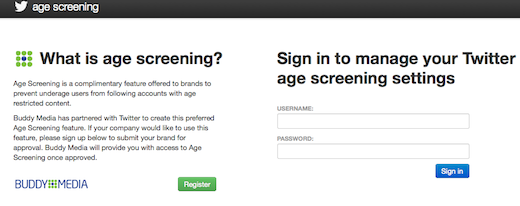 Twitter is out to improve its user experience for brands and for humans via a partnership with Buddy Media. The product? An age restriction tool designed to protect young people from content that’s not age appropriate. Imagine that—a UX that might actually give customers what they want!
Twitter is out to improve its user experience for brands and for humans via a partnership with Buddy Media. The product? An age restriction tool designed to protect young people from content that’s not age appropriate. Imagine that—a UX that might actually give customers what they want!
We probably all agree that when it comes to the Internet, access is pretty much unlimited—and that’s both good and terrible. And it’s especially terrible when you’re a brand producing content that’s only appropriate for certain age groups. Alcohol, gambling and other age-restricted brands are just as active in the social space as others, but that doesn’t mean their content is appropriate for all users. A new age-screening feature on Twitter is out to improve the age verification process, giving brands a more streamlined option. A win for brands and a win for parents (and the kids they strive to protect).
As mentioned, the age-screening feature is the result of a partnership between Twitter and social media analytics firm Buddy Media. The tool recently emerged from beta tests conducted by a small group of alcohol brands including Jack Daniels, Skinny Girl and Coors Light.
To use the tool, your brand has to apply (see below). Once approved, you’ll have access to the feature and be able to manage various settings, including a customized message that appears when new users follow your brand.
Once a user meets the age restrictions you’ve set, they’ll automatically follow you. If they don’t, following will not be permitted. And once a Twitter user has verified his or her age with one brand, they won’t need to complete the process again with other brands that are using the same tool.
The tool is free, and although we think it’s a great idea, it’s certainly not a fool-proof solution. Kids can easily lie about their age online (I know I was an expert at lying about my age back in the day) (weren’t you?), and when you’re talking specifically about Twitter, anyone can read a Twitter user’s tweets unless the account is private.
Still, it seems like an initial step in the right direction. This tool lets age-sensitive brands take some measure to protect both themselves and young people (at least when it comes to Twitter) rather than having to create their own system that may or may not work.
As a final point, this is smart monetization strategy on the part of Twitter and Buddy Media. And Twitter has struggled with monetization. This? Something that may or may not work, but which brands that sell products that shouldn’t be marketed to children can, and probably will, buy, to add a layer of protection and ‘we’re doing the right thing’ to their marketing campaigns. Doesn’t that only make sense?
What’s your take on the Twitter age verification feature? Smart addition, or too easily exploited to be of any real use? Would love for you to dive in, check it out and come back and share your thoughts.
Photo by mockstar via Creative Commons
